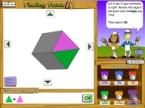Students explore the properties of, and relationship between, 2D shapes (polygons) and 3D objects (polyhedrons) by visualising the shapes of the faces of objects, including those distorted by perspective and hidden from view.
Teacher notes
- Students estimate the number of a specific 2D shape that can be found on a given 3D object.
- Students rotate and view the 3D object from all perspectives and identify each instance of the 2D shape by painting it.
- Numbers of shapes correctly painted are automatically recorded and updated enabling the student to compare their estimate with the result.
- Students visualise relationships between 2D figures and 3D objects.
- The controlled way in which the object must be rotated around horizontal and vertical axes provides a more systematic approach to the exploration of the structure of the shapes than would normally be possible through physical handling of the objects.
Learning objects
 |
Face painter: finding faces 1 |